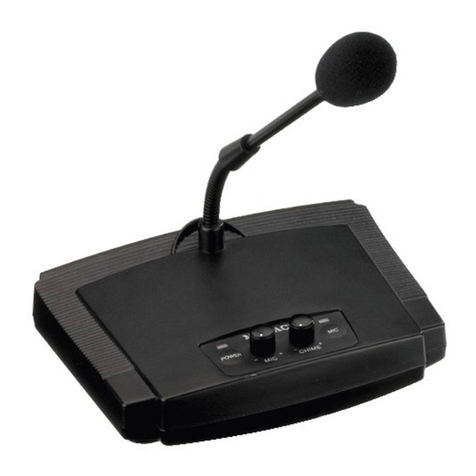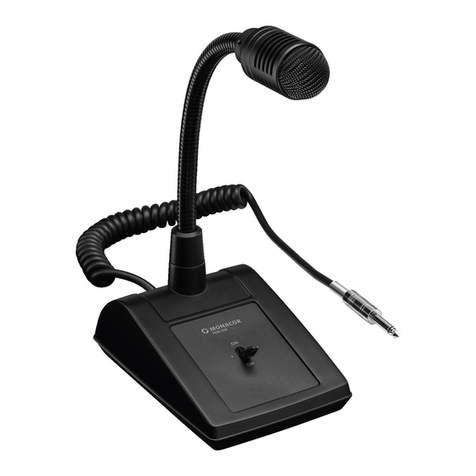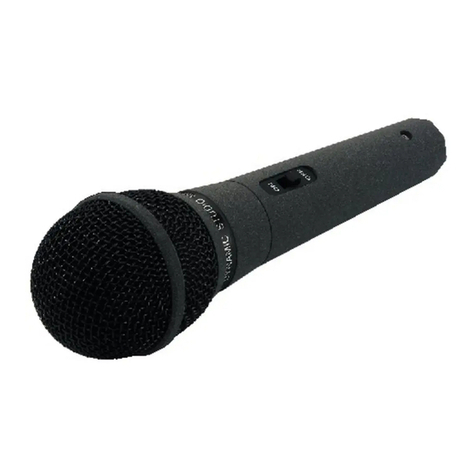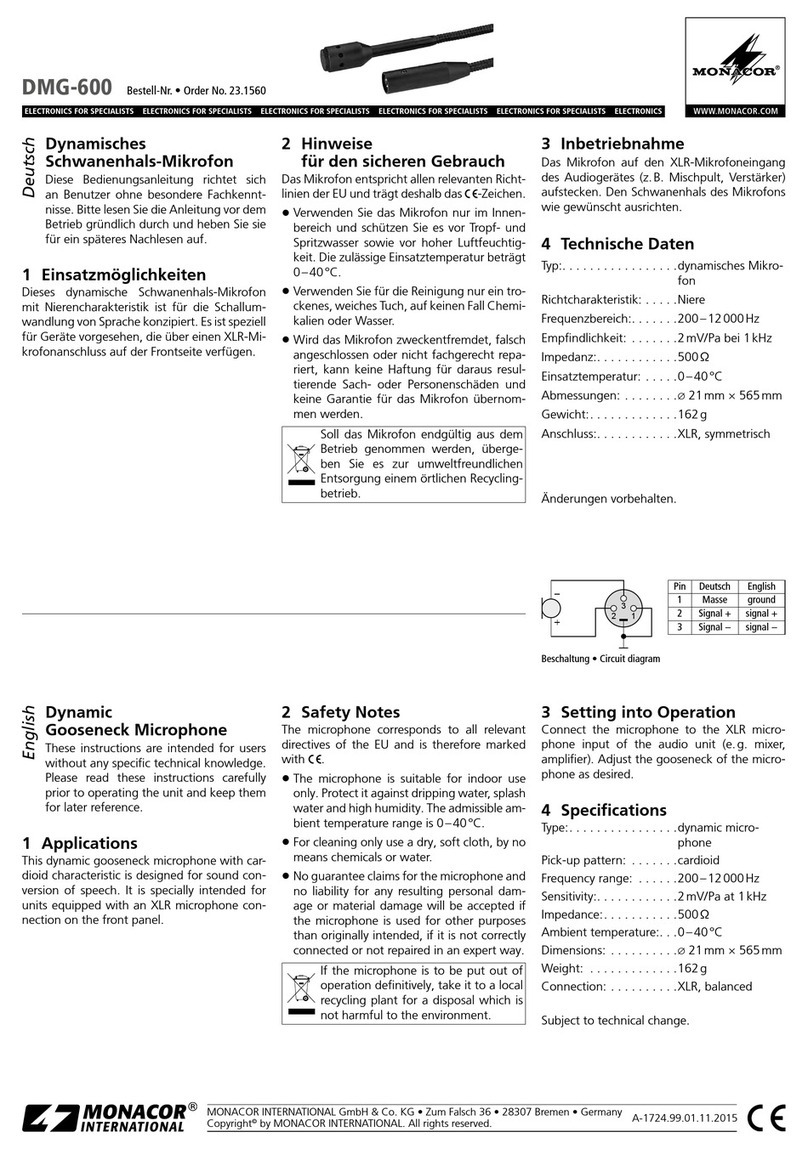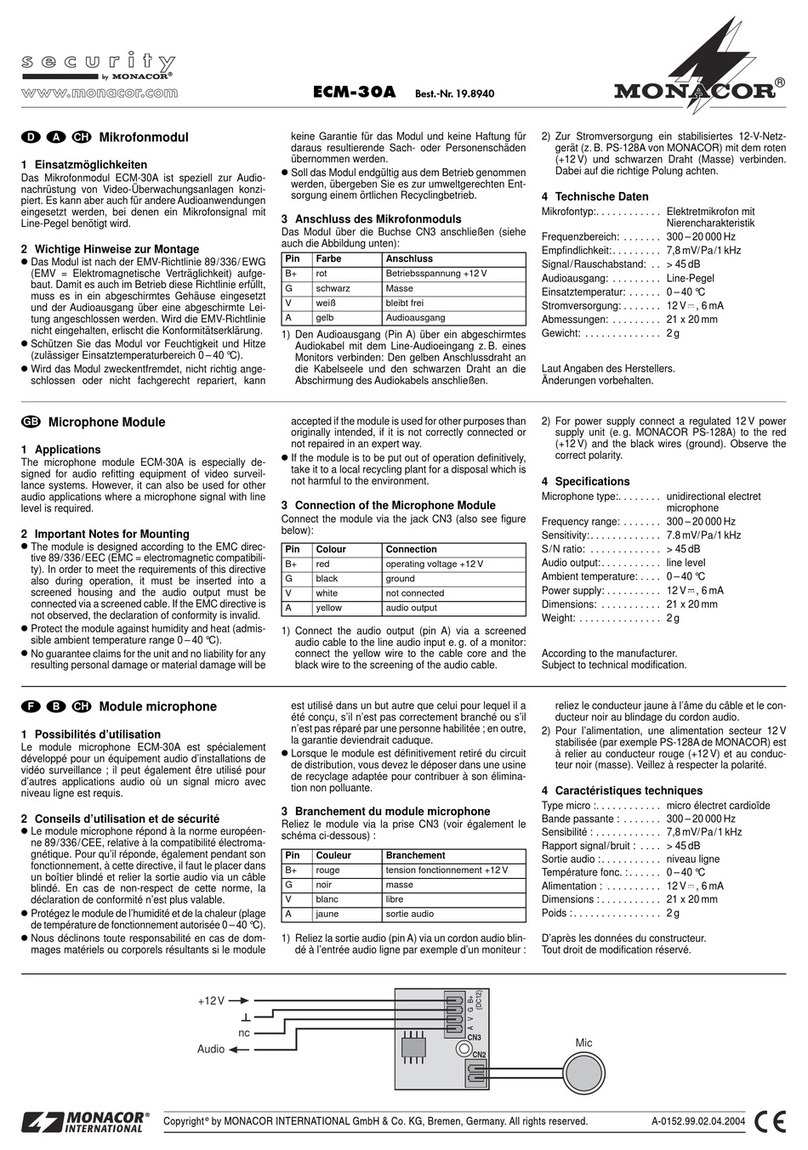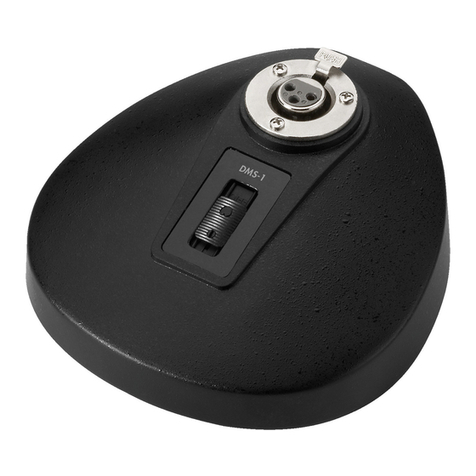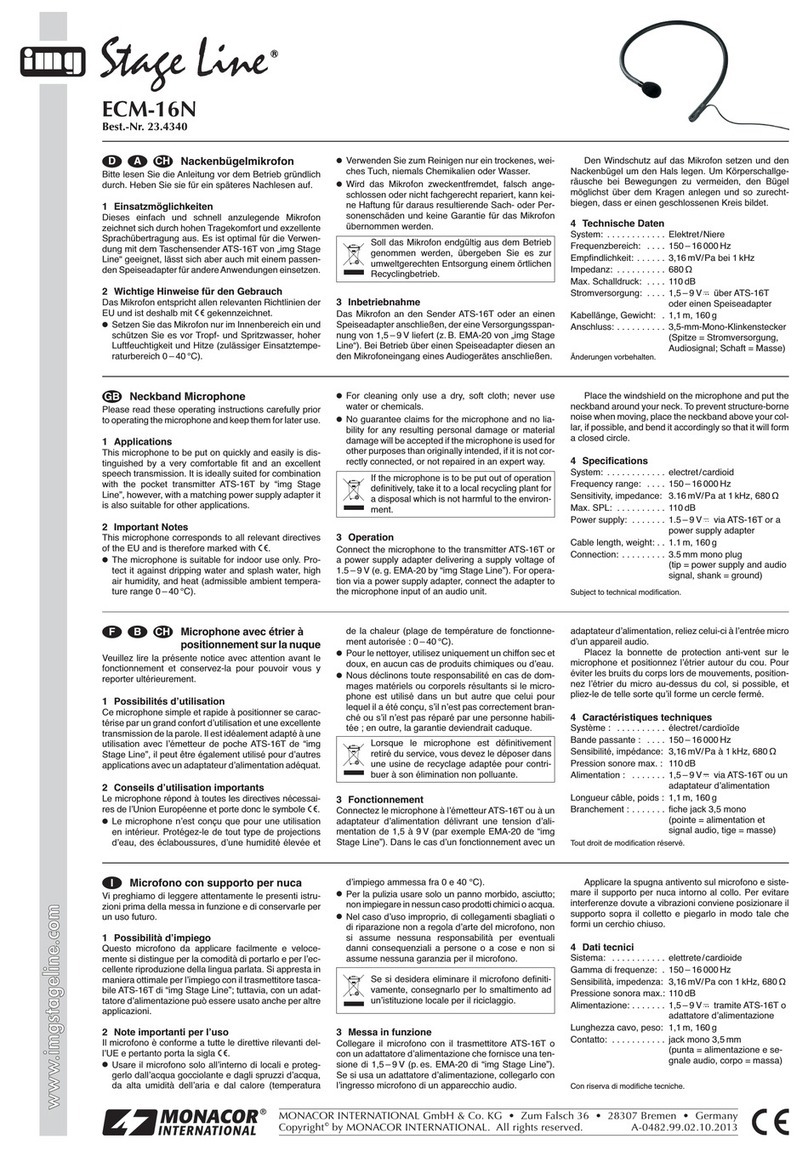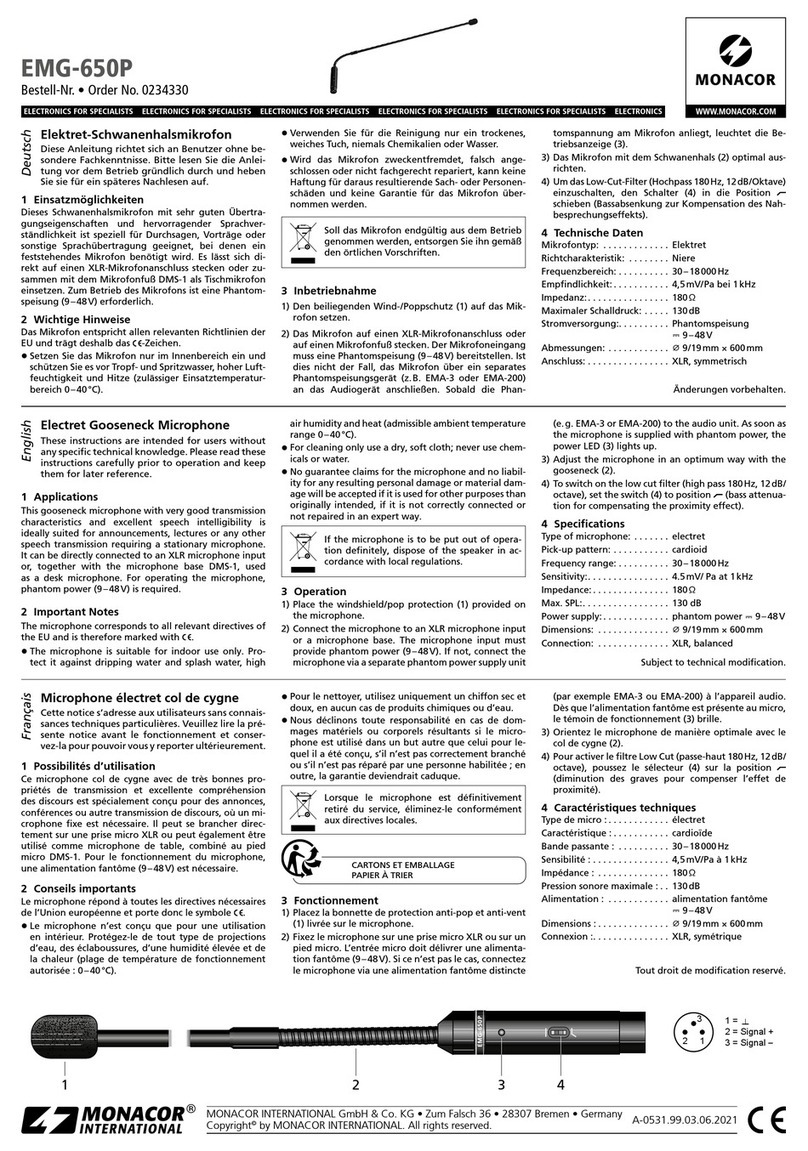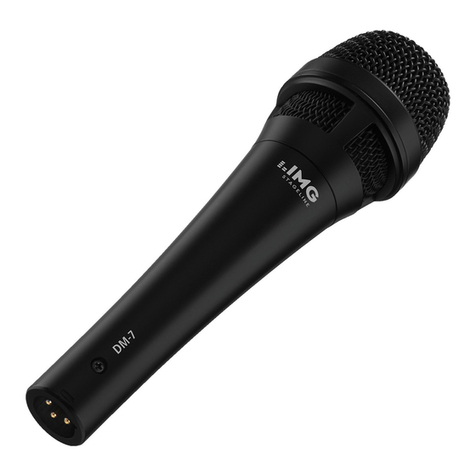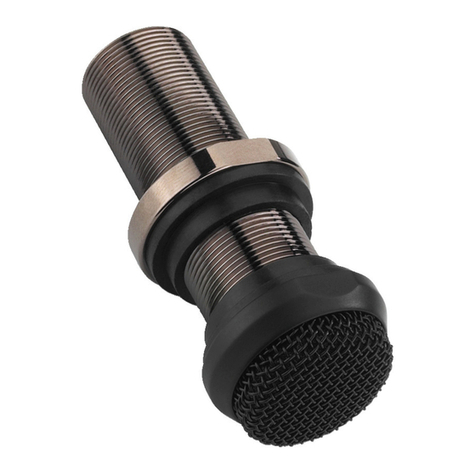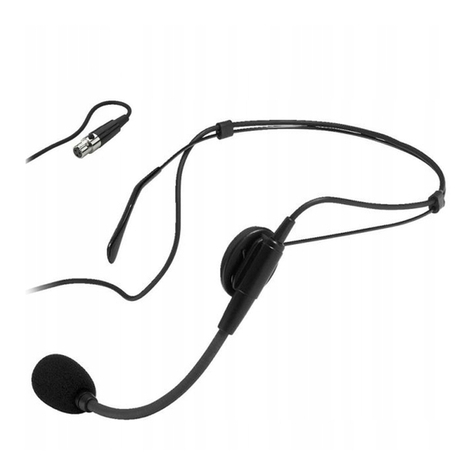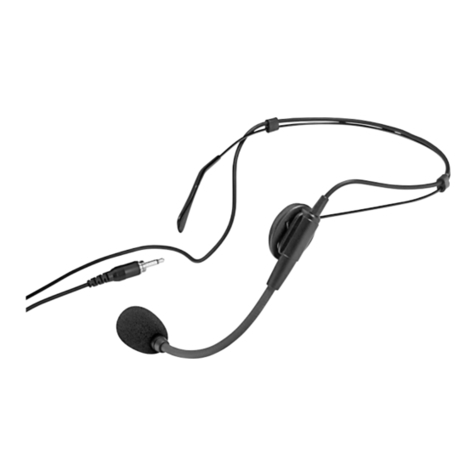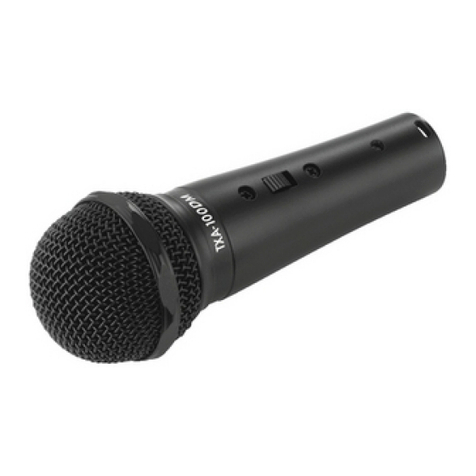DM-4500
Best.-Nr. 23.5150
wwwwww..iimmggssttaaggeelliinnee..ccoomm
Copyright ©by MONACOR INTERNATIONAL GmbH & Co. KG, Bremen, Germany. All rights reserved. A-0671.99.01.09.2006
®
Microphone dynamique
Veuillez lire la présente notice avec attention
avant le fonctionnement et conservez-la pour
pouvoir vous y reporter ultérieurement.
1Possibilités d’utilisation
Le microphone dynamique DM-4500 est idéal
pour des applications de chant et de discours
sur scène, dans un théâtre, en discothèque etc.
Il a un corps métallique solide et est équipé d’un
interrupteur Reed pour un allumage/une extinc-
tion pauvre en bruit. Il est livré avec une pince
micro, un cordon de branchement et un coffret
de transport.
2Conseils importants d’utilisation
Le microphone répond à toutes les directives
nécessaires de l’Union Européenne et porte
donc le symbole .
●Le microphone n’est conçu que pour une utili-
sationenintérieur, protégez-le des projections
d’eau et éclaboussures, d’une humidité éle-
vée de l’air et de la chaleur (plage de tempéra-
ture de fonctionnement autorisée 0–40°C).
●Pour le nettoyer, utilisez uniquement un chif-
fon sec et doux, en aucun cas de produits chi-
miques ou d’eau.
●Nous déclinons toute responsabilité en cas de
dommages matériels ou corporels résultants
si le microphone est utilisé dans un but autre
que celui pour lequel il a été conçu, s’il n’est
pas correctement branché ou s’il n’est pas
réparé par une personne habilitée ; en outre,
la garantie deviendrait caduque.
3Fonctionnement
1) Reliez le microphone via le cordon à l’entrée
micro d’un appareil audio (p.ex. table de
mixage, enregistreur, amplificateur). Si l’ap-
pareil possède uniquement comme entrée
micro, une prise jack, utilisez un adaptateur
XLR/jack adéquat (p.ex. pour des entrées
asymétriques le NTA-117 ou pour des entrées
symétriques le NTA-118 de MONACOR).
2) Vissez la pince micro sur un pied doté d’un
filetage 15,9mm (5/8") ou, via un adaptateur
fileté, sur un pied avec un filetage 9,5mm
Lorsque le microphone est définitive-
ment retiré du service, vous devez le
déposer dans une usine de recyclage
adaptée pour contribuer à son élimina-
tion non polluante.
(3/8"), poussez ensuite le microphone dans la
pince de telle sorte qu’il soit bien fixé.
3) Pour orienter le microphone, desserrez la vis
de réglage sur la pince micro, orientez le
microvers lasourceaudio puis revissezla vis.
4) Pour allumer le microphone, poussez l’inter-
rupteur vers la capsule.
4Caractéristiques techniques
Directivité : . . . . . . . . . . cardioïde
Bande passante : . . . . . 50–16500Hz
Sensibilité : . . . . . . . . . 1,8mV/Pa à 1kHz
Pression sonore
maximale : . . . . . . . . . . 147dB
Impédance : . . . . . . . . . 600Ω
Température fonc. : . . . 0–40°C
Dimensions : . . . . . . . . Ø 51 mm ×165mm
Poids : . . . . . . . . . . . . . 290g
Branchement : . . . . . . . XLR, symétrique
Cordon : . . . . . . . . . . . . 6m
Tout droit de modification réservé.
Microfono dinamico
Vi preghiamo di leggere attentamente le pre-
senti istruzioni prima dell’uso e di conservarle
per un uso futuro.
1Possibilità d’impiego
Ilmicrofono dinamicoDM-4500si prestain modo
ottimale per applicazioni di canto e di lingua par-
lata nello spettacolo, a teatro o in discoteca ecc.
È equipaggiato con un corpo robusto di metallo
e con un interruttore reed che permette l’accen-
sione e lo spegnimento con rumore ridotto. Sono
in dotazione un supporto per il microfono, un
cavodi collegamentoeuna valigettadi trasporto.
2Avvertenze importanti per l’uso
Il microfono è conforme a tutte le direttive richie-
ste dell’UE e pertanto porta la sigla .
●Usare il microfono solo all’interno di locali.
Proteggerlo dall’acqua gocciolante e dagli
spruzzi d’acqua, da alta umidità dell’aria e dal
calore (temperatura d’impiego ammessa fra
0 e 40°C).
●Per la pulizia usare solo un panno morbido,
asciutto; non impiegare in nessun caso pro-
dotti chimici o acqua.
●Nel caso d’uso improprio, di collegamento
sbagliato o di riparazione non a regola d’arte
del microfono, non si assume nessuna re-
sponsabilità per eventuali danni consequen-
ziali a persone o a cose e non si assume nes-
suna garanzia per il microfono.
3Messa in funzione
1) Collegare il microfono con l’ingresso micro-
fono di un apparecchio audio (p.es. mixer,
registratore, amplificatore) servendosi del
cavo in dotazione. Se l’apparecchio, come
ingresso microfono, ha solo una presa jack
occorre usare un adattatore XLR-jack (p.es.
per ingressi asimmetrici NTA-117 e per
ingressi simmetrici NTA-118 di MONACOR).
2) Avvitare il supporto su uno stativo con filetta-
tura 15,9mm (5/8") oppure, utilizzando un
adattatore filettato, su uno stativo con filetta-
tura 9,5mm (3/8") e inserire il microfono nel
supporto in modo che sia tenuto bene.
Se si desidera eliminare il microfono
definitivamente, consegnarlo per lo
smaltimento ad un’istituzione locale
per il riciclaggio.
3) Per orientare il microfono, allentare la vite di
bloccaggio del supporto, orientare il micro-
fono verso la sorgente sonora e stringere di
nuovo la vite.
4) Per accendere il microfono, spostare l’inter-
ruttore in direzione del cestello del microfono.
4Dati tecnici
Caratteristica direzionale: cardioide
Gamma di frequenze: . . . 50–16500Hz
Sensibilità: . . . . . . . . . . . 1,8mV/Pa con 1kHz
Pressione sonora max.: . 147dB
Impedenza: . . . . . . . . . . . 600Ω
Temperatura d’esercizio: 0–40°C
Dimensioni: . . . . . . . . . . . Ø 51mm ×165mm
Peso: . . . . . . . . . . . . . . . 290g
Contatto: . . . . . . . . . . . . . XLR, simm.
Cavo: . . . . . . . . . . . . . . . 6m
Con riserva di modifiche tecniche.
